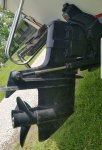WalleyeSniper
Petty Officer 2nd Class
- Joined
- May 15, 2018
- Messages
- 108
I know this is probably been addressed 100x, and I've seen many explanations and comparisons on the forums. But, for the life of me, I cannot decipher which outrive I have on my new (used) boat.
The best I can come up with, is that it's more than likely "R/MR Alpha One". But, even if I'm correct, I still don't understand the R/MR part or the difference between an Alpha One and Alpha One GEN 1. The way I understand it, is that R and MR are different, so I'm kinda confused as to why it comes back as R/MR when running the serial #. (Serial: 6930159).
Any help on exactly what I have would be greatly appreciated!
The reason I'm asking, is because when the drive is
trimmed up a little bit while running, there's a slight "clinking/looser sounding" noise near where I think the U-Joint or Gimbal area is, and I'm trying to figure out what I should be looking at addressing to get rid of the noise. Just Ujoints? Or should I go ahead and get a new gimbal and ujoints? Just looking for
opinions. When it's trimmed down or only part way up, it runs, sounds, and operates beautifully.
The best I can come up with, is that it's more than likely "R/MR Alpha One". But, even if I'm correct, I still don't understand the R/MR part or the difference between an Alpha One and Alpha One GEN 1. The way I understand it, is that R and MR are different, so I'm kinda confused as to why it comes back as R/MR when running the serial #. (Serial: 6930159).
Any help on exactly what I have would be greatly appreciated!
The reason I'm asking, is because when the drive is
trimmed up a little bit while running, there's a slight "clinking/looser sounding" noise near where I think the U-Joint or Gimbal area is, and I'm trying to figure out what I should be looking at addressing to get rid of the noise. Just Ujoints? Or should I go ahead and get a new gimbal and ujoints? Just looking for
opinions. When it's trimmed down or only part way up, it runs, sounds, and operates beautifully.




















